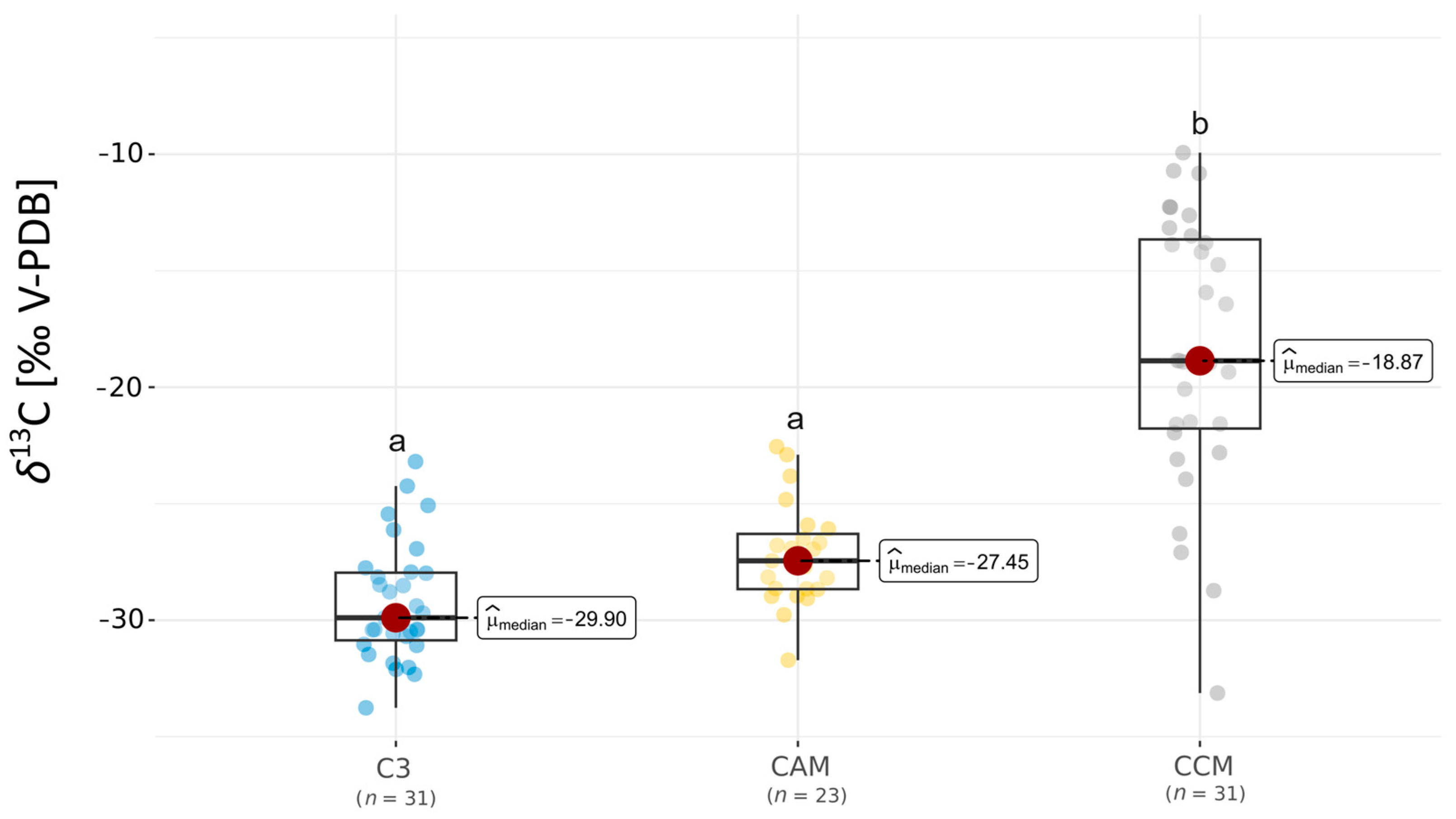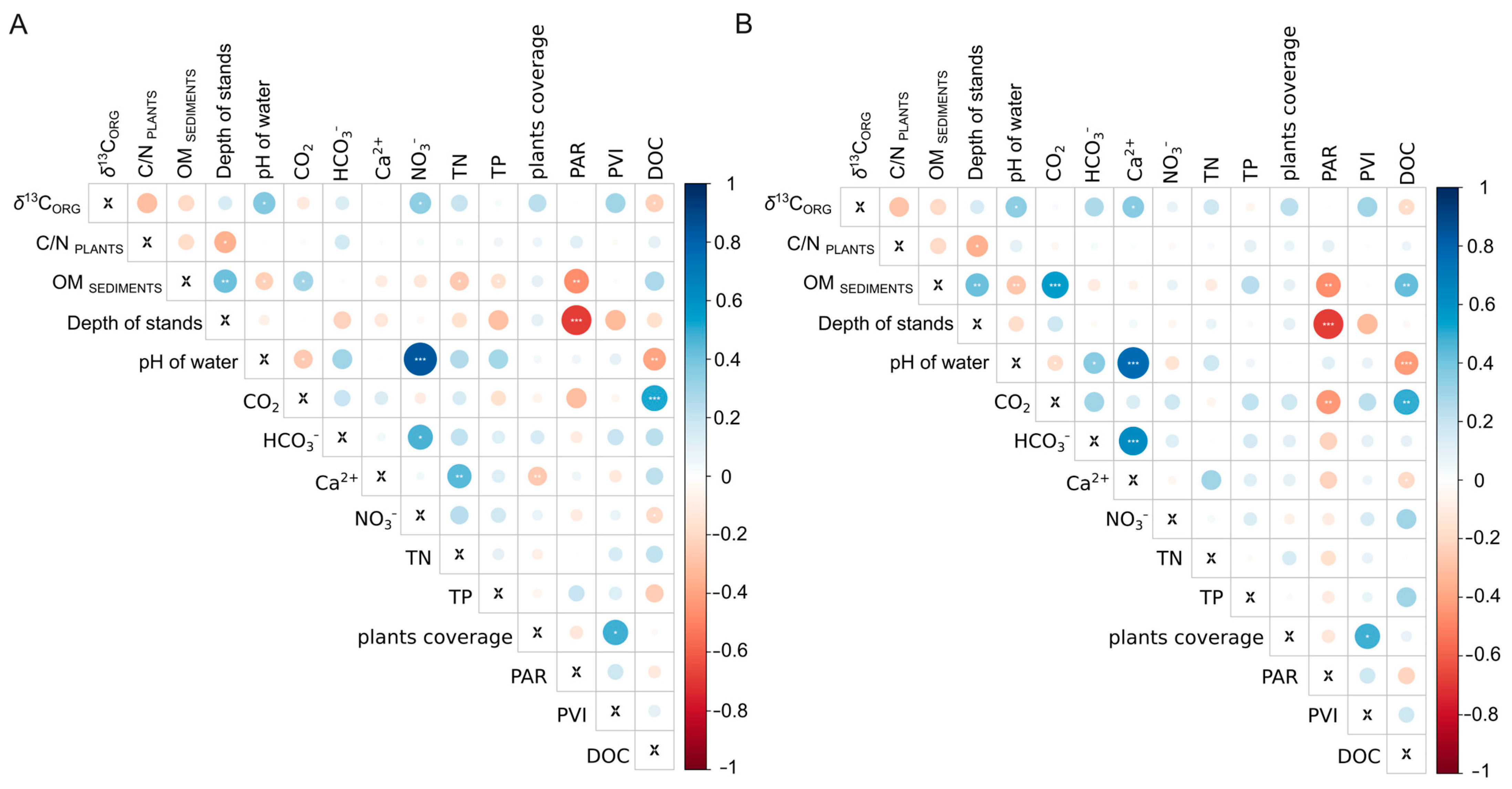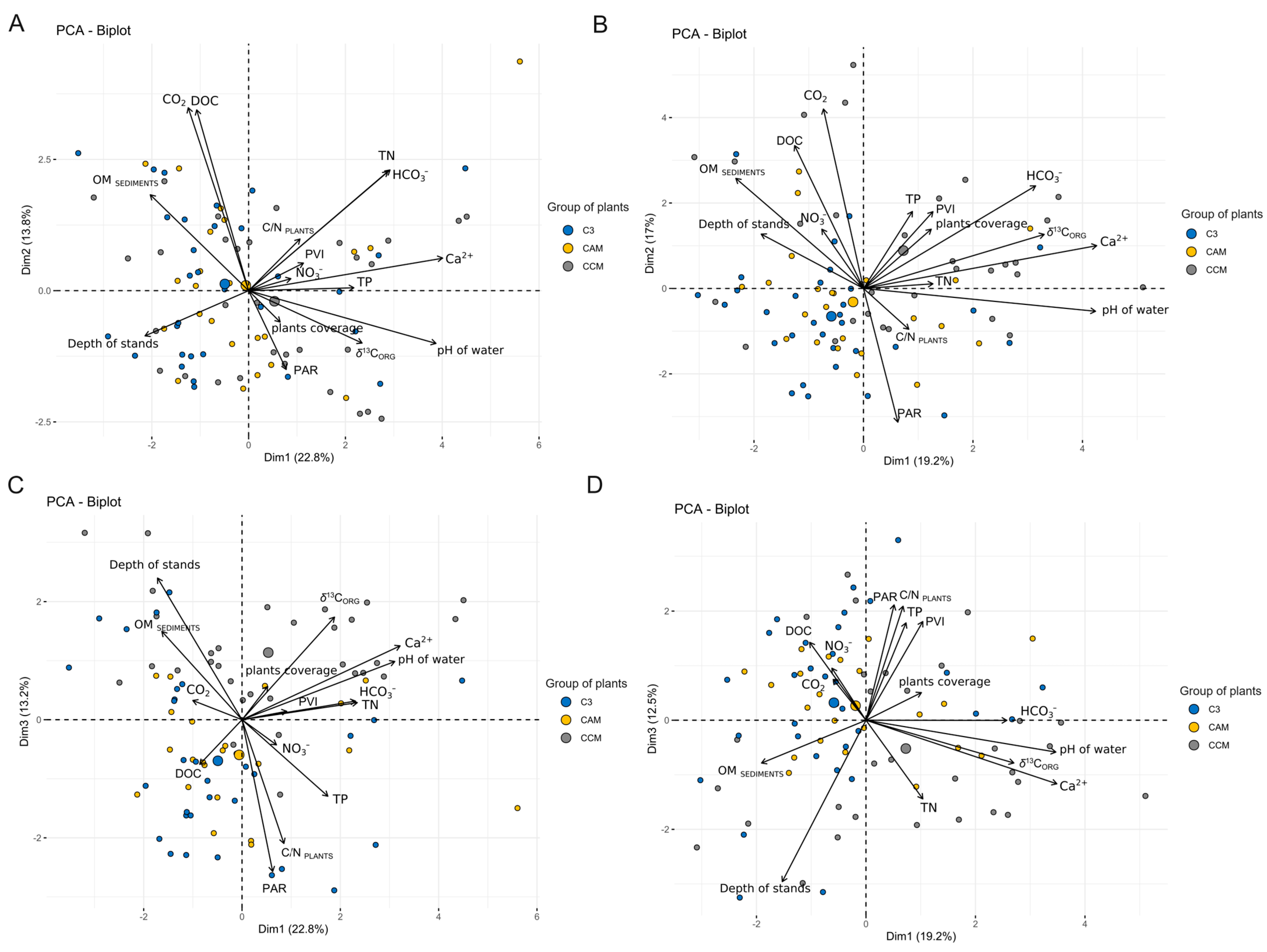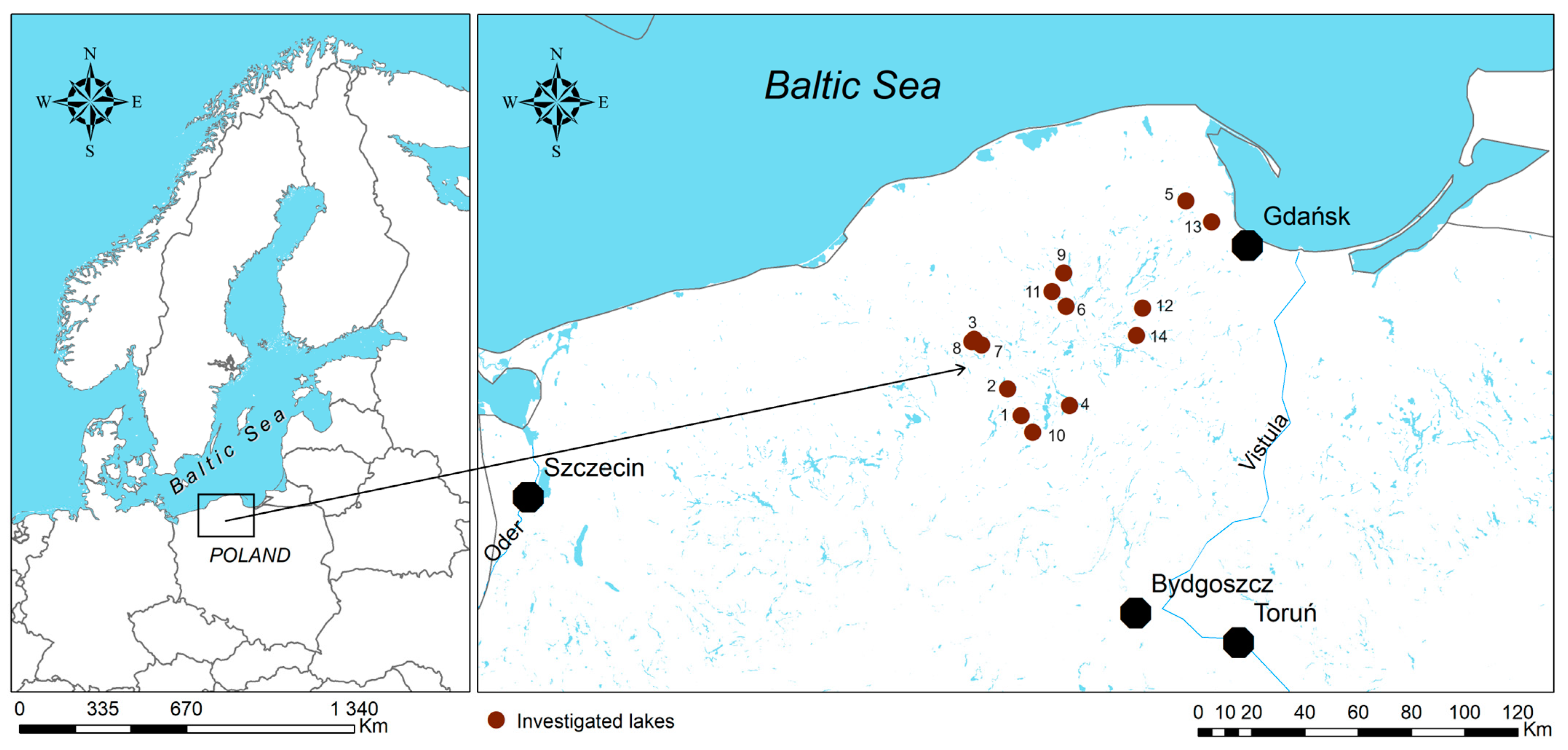Lobelia Lakes’ Vegetation and Its Photosynthesis Pathways Concerning Water Parameters and the Stable Carbon Isotopic Composition of Plants’ Organic Matter
Abstract
1. Introduction
2. Results
2.1. δ13CORG Values of Plants in the Light of the Photosynthetic Group and Mechanisms
2.2. Relationships between Water Physicochemical Variables and the δ13CORG of Plant and Sediments OM
3. Discussion
4. Materials and Methods
4.1. Study Sites
4.2. Field Study
4.3. Laboratory Variable Analysis of Water Collected in the Field
4.4. The Analyses of Plant Material, Including δ13CORG Analyses
4.5. Statistical Analysis
5. Conclusions
Supplementary Materials
Author Contributions
Funding
Data Availability Statement
Acknowledgments
Conflicts of Interest
References
- Herzschuh, U.; Mischke, S.; Meyer, H.; Plessen, B.; Zhang, C. Using Variations in the Stable Carbon Isotope Composition of Macrophyte Remains to Quantify Nutrient Dynamics in Lakes. J. Paleolimnol. 2010, 43, 739–750. [Google Scholar] [CrossRef]
- Gąsiorowski, M.; Sienkiewicz, E. The Sources of Carbon and Nitrogen in Mountain Lakes and the Role of Human Activity in Their Modification Determined by Tracking Stable Isotope Composition. Water. Air. Soil Pollut. 2013, 224. [Google Scholar] [CrossRef] [PubMed]
- Pronin, E.; Panettieri, M.; Torn, K.; Rumpel, C. Stable Carbon Isotopic Composition of Dissolved Inorganic Carbon (DIC) as a Driving Factor of Aquatic Plants Organic Matter Build-up Related to Salinity. Ecol. Indic. 2019, 99, 230–239. [Google Scholar] [CrossRef]
- Chappuis, E.; Seriñá, V.; Martí, E.; Ballesteros, E.; Gacia, E. Decrypting Stable-Isotope (δ13C and δ15N) Variability in Aquatic Plants. Freshw. Biol. 2017, 62, 1807–1818. [Google Scholar] [CrossRef]
- Pronin, E.; Pełechaty, M.; Apolinarska, K.; Pukacz, A.; Frankowski, M. Sharp Differences in the δ13C Values of Organic Matter and Carbonate Encrustations but Not in Ambient Water DIC between Two Morphologically Distinct Charophytes. Hydrobiologia 2016, 773, 177–191. [Google Scholar] [CrossRef]
- Apolinarska, K.; Pełechaty, M.; Pronin, E. Discrepancies between the Stable Isotope Compositions of Water, Macrophyte Carbonates and Organics, and Mollusc Shells in the Littoral Zone of a Charophyte-Dominated Lake (Lake Lednica, Poland). Hydrobiologia 2016, 768, 1–17. [Google Scholar] [CrossRef]
- Zhang, P.; Kong, X.; Bakker, E.S.; Xu, J.; Zhang, M. Temperature Affects Carbon and Nitrogen Stable Isotopic Signatures of Aquatic Plants. Aquat. Sci. 2021, 83, 39. [Google Scholar] [CrossRef]
- Liu, H.; Liu, J.; Hu, J.; Cao, Y.; Xiao, S.; Liu, W. Systematical δ13C Investigations of TOC in Aquatic Plants, DIC and Dissolved CO 2 in Lake Water from Three Tibetan Plateau Lakes. Ecol. Indic. 2022, 140, 109060. [Google Scholar] [CrossRef]
- King, L.; Maberly, S.C.; De Ville, M.M.; Kitschke, M.; Gibson, C.E.; Jones, R.I. Nitrogen Stable Isotope Ratios of Lake Macrophytes in Relation to Growth Form and Nutrient-Limitation. Fundam. Appl. Limnol. 2009, 175, 307–315. [Google Scholar] [CrossRef]
- Matuszak, A.; Voigt, C.C.; Storch, I.; Bauer, H.G.; Quillfeldt, P. Depth-Specific and Spatiotemporal Variation of δ13C and δ15N in Charophytes of Lake Constance: Implications for Food Web Studies. Rapid Commun. Mass Spectrom. 2011, 25, 2089–2094. [Google Scholar] [CrossRef]
- Pronin, E.; Banaś, K.; Chmara, R.; Ronowski, R.; Merdalski, M. Do Stable Carbon and Nitrogen Isotope Values of Nitella Flexilis Differ between Softwater and Hardwater Lakes? Aquat. Sci. 2023, 85, 79. [Google Scholar] [CrossRef]
- Pronin, E. The Possible Use of Stable Carbon and Nitrogen Isotope Signal and Spectral Analysis to Identify Habitat Condition of Aquatic Plants. Limnol. Rev. 2024, 24, 17–29. [Google Scholar] [CrossRef]
- Kohn, M.J. Carbon Isotope Compositions of Terrestrial C3 Plants as Indicators of (Paleo)Ecology and (Paleo)Climate. Proc. Natl. Acad. Sci. USA 2010, 107, 19691–19695. [Google Scholar] [CrossRef]
- Cerling, T.E. Paleorecords of C4 Plants and Ecosystems. In C4 Plant Biology; Sage, R.F., Monson, R.K., Eds.; Elsevier: Amsterdam, The Netherlands, 1999; pp. 445–469. [Google Scholar]
- Keeley, J.E.; Sternberg, L.O.; Deniro, M.J. The Use of Stable Isotopes in the Study of Photosynthesis in Freshwater Plants. Aquat. Bot. 1986, 26, 213–223. [Google Scholar] [CrossRef]
- Osmond, C.B.; Valaane, N.; Haslam, S.M.; Uotila, P.; Roksandic, Z. Comparisons of δ13C Values in Leaves of Aquatic Macrophytes from Different Habitats in Britain and Finland; Some Implications for Photosynthetic Processes in Aquatic Plants. Oecologia 1981, 50, 117–124. [Google Scholar] [CrossRef] [PubMed]
- Richardson, K.; Griffiths, H.; Reed, M.L.; Raven, J.A.; Griffiths, N.M. Inorganic Carbon Assimilation in the Isoetids, Isoetes lacustris L. and Lobelia dortmanna L. Oecologia 1984, 61, 115–121. [Google Scholar] [CrossRef]
- Pajusalu, L.; Albert, G.; Fachon, E.; Hepburn, C.D.; Kotta, J.; Kõivupuu, A.; Paalme, T.; Pritchard, D.W.; Põllumäe, A.; Torn, K.; et al. Species-Specific Responses of Macrophyte Production to the Increasing CO2 Environment with Potential Ecosystem Implications Involved in the Baltic Sea. J. Appl. Phycol. 2023, 36, 983–994. [Google Scholar] [CrossRef]
- Smolders, A.J.P.; Lucassen, E.C.H.E.T.; Roelofs, J.G.M. The Isoetid Environment: Biogeochemistry and Threats. Aquat. Bot. 2002, 73, 325–350. [Google Scholar] [CrossRef]
- Møller, C.L.; Sand-Jensen, K. Rapid Oxygen Exchange across the Leaves of Littorella Uniflora Provides Tolerance to Sediment Anoxia. Freshw. Biol. 2012, 57, 1875–1883. [Google Scholar] [CrossRef]
- Roelofs, J.G.M.; Schuurkes, J.A.A.R.; Smits, A.J.M. Impact of Acidification and Eutrophication on Macrophyte Communities in Soft Waters. II. Experimental Studies. Aquat. Bot. 1984, 18, 389–411. [Google Scholar] [CrossRef]
- Sand-Jensen, K.; Madsen, T.V. Minimum Light Requirements of Submerged Freshwater Macrophytes in Laboratory Growth Experiments. J. Ecol. 1991, 79, 749. [Google Scholar] [CrossRef]
- Nielsen, S.L.; Sand-Jensen, K. Variation in Growth Rates of Submerged Rooted Macrophytes. Aquat. Bot. 1991, 39, 109–120. [Google Scholar] [CrossRef]
- O’Leary, M.H. Carbon Isotopes in Photosynthesis. Bioscience 1988, 38, 328–336. [Google Scholar] [CrossRef]
- Iversen, L.L.; Winkel, A.; Baastrup-Spohr, L.; Hinke, A.B.; Alahuhta, J.; Baattrup-Pedersen, A.; Birk, S.; Brodersen, P.; Chambers, P.A.; Ecke, F.; et al. Catchment Properties and the Photosynthetic Trait Composition of Freshwater Plant Communities. Science 2019, 366, 878–881. [Google Scholar] [CrossRef] [PubMed]
- Raven, J.A.; Beardall, J.; Giordano, M. Energy Costs of Carbon Dioxide Concentrating Mechanisms in Aquatic Organisms. Photosynth. Res. 2014, 121, 111–124. [Google Scholar] [CrossRef]
- Sand-Jensen, K.; Gordon, D.M. Variable HCO3− Affinity of Elodea Canadensis Michaux in Response to Different HCO3− and CO2 Concentrations during Growth. Oecologia 1986, 70, 426–432. [Google Scholar] [CrossRef]
- Maberly, S.C.; Madsen, T.V. Freshwater Angiosperm Carbon Concentrating Mechanisms: Processes and Patterns. Funct. Plant Biol. 2002, 29, 393. [Google Scholar] [CrossRef]
- Ronowski, R.P.; Banaś, K.; Merdalski, M.; Szmeja, J. Plant Replacement Trend in Soft-Water Lakes with Isoetids. Oceanol. Hydrobiol. Stud. 2020, 49, 157–167. [Google Scholar] [CrossRef]
- Klimaszyk, P.; Borowiak, D.; Piotrowicz, R.; Rosińska, J.; Szeląg-Wasielewska, E.; Kraska, M. The Effect of Human Impact on the Water Quality and Biocoenoses of the Soft Water Lake with Isoetids: Jeleń Lake, NW Poland. Water 2020, 12, 945. [Google Scholar] [CrossRef]
- Kolada, A.; Piotrowicz, R.; Wilk-Woźniak, E.; Dynowski, P.; Klimaszyk, P. Conservation Status of the Natura 2000 Habitat 3110 in Poland: Monitoring, Classification and Trends. Limnol. Rev. 2017, 17, 215–222. [Google Scholar] [CrossRef]
- Keeley, J.E.; Rundel, P.W. Evolution of CAM and C4Carbon-Concentrating Mechanisms. Int. J. Plant Sci. 2003, 164, S55–S77. [Google Scholar] [CrossRef]
- Chmara, R.; Pronin, E.; Szmeja, J. Functional Macrophyte Trait Variation as a Response to the Source of Inorganic Carbon Acquisition. PeerJ 2021, 9, e12584. [Google Scholar] [CrossRef] [PubMed]
- Szańkowski, M.; Kłosowski, S. Habitat Variability of the Littorelletea Uniflorae Plant Communities in Polish Lobelia Lakes. Hydrobiologia 2006, 570, 117–126. [Google Scholar] [CrossRef]
- Murphy, K.J. Plant Communities and Plant Diversity in Softwater Lakes of Northern Europe. Aquat. Bot. 2002, 73, 287–324. [Google Scholar] [CrossRef]
- Sundberg, C.; Jönsson, H. Higher PH and Faster Decomposition in Biowaste Composting by Increased Aeration. Waste Manag. 2008, 28, 518–526. [Google Scholar] [CrossRef]
- Zhang, J.; Zhang, M.; Kuang, W.; Zhu, G.; Wang, Y.; Lu, L.; Xu, J. Characteristics of Stable Carbon and Nitrogen Isotope Signatures of Aquatic Plants to Algal Blooms in Poyang Lake. Res. Environ. Sci. 2016, 29, 708–715. [Google Scholar] [CrossRef]
- Lucas, W.J. Photosynthetic Assimilation of Exogenous HCO3 by Aquatic Plants. Annu. Rev. Plant Physiol. 1983, 34, 71–104. [Google Scholar] [CrossRef]
- Pełechaty, M.; Apolinarska, K.; Pukacz, A.; Krupska, J.; Siepak, M.; Boszke, P.; Sinkowski, M. Stable Isotope Composition of Chara Rudis Incrustation in Lake Jasne, Poland. Hydrobiologia 2010, 656, 29–42. [Google Scholar] [CrossRef]
- Merdalski, M.; Banaś, K.; Ronowski, R. Environmental Factors Affecting Pondweeds in Water Bodies of Northwest Poland. Biodivers. Res. Conserv. 2019, 56, 13–28. [Google Scholar] [CrossRef]
- R Core Team. R: A Language and Environment for Statistical Computing; The R Project for Statistical Computing: Vienna, Austria, 2022. [Google Scholar]
- Dinno, A. Package ‘Dunn.Test’. CRAN Repos. 2017, 10, 1–7. [Google Scholar]
- Wickham, H. Ggplot2; Springer: New York, NY, USA, 2009; ISBN 978-0-387-98140-6. [Google Scholar]
- Wei, T.; Simko, V.; Levy, M.; Xie, Y.; Jin, Y.; Zemla, J. R Package “Corrplot”: Visualization of a Correlation Matrix. Statistician 2017, 56, 316–324. [Google Scholar]
- Patil, I. Visualizations with Statistical Details: The “ggstatsplot” Approach. J. Open Source Softw. 2021, 6, 3167. [Google Scholar] [CrossRef]
- Lê, S.; Josse, J.; Husson, F. FactoMineR : An R Package for Multivariate Analysis. J. Stat. Softw. 2008, 25, 253–258. [Google Scholar] [CrossRef]
- Kassambara, A.; Mundt, F. Factoextra: Extract and Visualize the Results of Multivariate Data Analyses. R Package Version 1.0.7. Extr. Vis. Results Multivar. Data Anal.. 2020. Available online: https://cran.r-project.org/web/packages/factoextra/index.html (accessed on 10 July 2024).
- Oksanen, J.; Blanchet, F.G.; Friendly, M.; Kindt, R.; Legendre, P.; Mcglinn, D.; Minchin, P.R.; O’hara, R.B.; Simpson, G.L.; Solymos, P.; et al. Package “vegan” Title Community Ecology Package. Community Ecol. Packag. 2019, 2, 1–297. [Google Scholar]




| Lake | Lake Geographical Coordinates Converted | Lake Surface | Ca2+ | TN | TP | CO2 | HCO3− | DIC | OM | pH | Cond. |
|---|---|---|---|---|---|---|---|---|---|---|---|
| [km2] | [mg/L] | [mg N/L] | [mg P/L] | [mg C/L] | [mg C/L] | [mg C/L] | [%] | [µS cm−1] | |||
| 1. Linowskie | 53°46′38.27″ N, 17°21′49.00″ E | 0.14 | 1.73 ± 0.08 | 1.06 ± 0.08 | 0.02 ± 0.01 | 2.07 ± 0.61 | 5.54 ± 0.71 | 7.61 ± 0.74 | 4.02 ± 2.73 | 5.15 ± 0.24 | 22.83 ± 0.25 |
| 2. Krasne | 53°52′5.31″ N, 17°16′52.93″ E | 0.29 | 2.28 ± 0.12 | 0.83 ± 0.33 | 0.03 ± 0.01 | 1.58 ± 0.29 | 7.89 ± 0.57 | 9.47 ± 0.77 | 15.76 ± 1.60 | 5.90 ± 0.20 | 24.57 ± 0.32 |
| 3. Smołowe | 54°1′56.96″ N, 17°4′48.84″ E | 0.36 | 2.31 ± 0.22 | 0.70 ± 0.09 | 0.03 ± 0.01 | 1.90 ± 0.73 | 3.96 ± 0.28 | 5.79 ± 0.66 | 10.40 ± 15.33 | 6.21 ± 0.08 | 26.29 ± 0.57 |
| 4. Moczadło | 53°48′49.87″ N, 17°38′6.39″ E | 0.04 | 2.72 ± 0.09 | 0.66 ± 0.07 | 0.03 ± 0.02 | 1.20 ± 0.13 | 3.84 ± 0.63 | 5.04 ± 0.65 | 1.70 ± 1.16 | 6.24 ± 0.25 | 30.08 ± 1.19 |
| 5. Piasek | 54°0′46.71″ N, 17°7′4.50″ E | 0.41 | 3.74 ± 0.27 | 0.10 ± 0.14 | 0.06 ± 0.07 | 1.23 ± 0.24 | 6.08 ± 1.45 | 7.31 ± 1.48 | 6.74 ± 5.77 | 6.79 ± 0.19 | 50.10 ± 0.1.47 |
| 6. Kamień | 54°1′39.39″ N, 17°3′51.89″ E | 0.5 | 5.24 ± 0.15 | 0.54 ± 0.06 | 0.02 ± 0.01 | 1.49 ± 0.14 | 7.47 ± 0.37 | 8.96 ± 0.41 | 11.72 ± 11.94 | 6.79 ± 0.26 | 50.02 ± 3.86 |
| 7. Łąkie | 54°8′53.37″ N, 17°36′13.05″ E | 0.22 | 4.30 ± 0.19 | 0.56 ± 0.12 | 0.02 ± 0.02 | 1.97 ± 0.62 | 5.86 ± 0.79 | 7.83 ± 1.09 | 17.08 ± 20.68 | 6.69 ± 0.20 | 49.41 ± 1.12 |
| 8. Zawiad | 54°30′37.76″ N, 18°17′11.06″ E | 0.17 | 3.15 ± 0.19 | 0.77 ± 0.13 | 0.09 ± 0.06 | 0.94 ± 0.20 | 5.44 ± 2.58 | 6.42 ± 2.64 | 2.80 ± 1.92 | 7.16 ± 0.49 | 39.92 ± 0.35 |
| 9. Okoń Duży | 53°43′14.83″ N, 17°25′34.12″ E | 0.12 | 4.38 ± 0.05 | 1.23 ± 0.42 | 0.06 ± 0.07 | 1.36 ± 0.55 | 5.16 ± 0.53 | 6.52 ± 0.83 | 3.17 ± 1.74 | 7.44 ± 0.33 | 46.83 ± 2.58 |
| 10. Obrowo Małe | 54°15′40.13″ N, 17°35′12.42″ E | 0.09 | 2.95 ± 0.33 | 0.45 ± 0.06 | 0.09 ± 0.05 | 1.01 ± 0.14 | 4.22 ± 0.59 | 5.23 ± 0.57 | 6.02 ± 6.22 | 7.44 ± 0.55 | 30.14 ± 0.57 |
| 11. Jeleń | 54°11′52.46″ N, 17°31′14.75″ E | 0.81 | 6.42 ± 0.19 | 0.65 ± 0.34 | 0.07 ± 0.05 | 1.27 ± 0.78 | 4.89 ± 1.41 | 7.31 ± 1.33 | 5.16 ± 3.84 | 8.14 ± 0.40 | 56.41 ± 0.95 |
| 12. Dobrogoszcz | 54°8′49.62″ N, 18°2′30.012″ E | 0.54 | 11.95 ± 0.21 | 1.34 ± 0.10 | 0.04 ± 0.02 | 1.52 ± 0.33 | 8.33 ± 0.81 | 9.86 ± 0.72 | 1.04 ± 0.04 | 8.30 ± 0.10 | 193.50 ± 0.98 |
| 13. Osowskie | 54°26′24.85″ N, 18°26′13.28″ E | 0.28 | 15.30 ± 0.18 | 2.55 ± 0.64 | 0.15 ± 0.10 | 1.95 ± 0.47 | 10.30 ± 030 | 12.25 ± 0.77 | 2.22 ± 0.50 | 8.75 ± 0.65 | 142.95 ± 0.09 |
| 14. Zakrzewie | 54°3′14.86″ N, 18°0′39.54″ E | 0.10 | 10.37 ± 0.06 | 0.90 ± 0.07 | 0.02 ± 0.01 | 0.32 ± 0.52 | 6.41 ± 1.04 | 7.49 ± 1.24 | 0.80 ± 0.30 | 9.05 ± 0.08 | 69.12 ± 0.61 |
Disclaimer/Publisher’s Note: The statements, opinions and data contained in all publications are solely those of the individual author(s) and contributor(s) and not of MDPI and/or the editor(s). MDPI and/or the editor(s) disclaim responsibility for any injury to people or property resulting from any ideas, methods, instructions or products referred to in the content. |
© 2024 by the authors. Licensee MDPI, Basel, Switzerland. This article is an open access article distributed under the terms and conditions of the Creative Commons Attribution (CC BY) license (https://creativecommons.org/licenses/by/4.0/).
Share and Cite
Pronin, E.; Banaś, K.; Chmara, R.; Ronowski, R.; Merdalski, M.; Santoni, A.-L.; Mathieu, O. Lobelia Lakes’ Vegetation and Its Photosynthesis Pathways Concerning Water Parameters and the Stable Carbon Isotopic Composition of Plants’ Organic Matter. Plants 2024, 13, 2529. https://doi.org/10.3390/plants13172529
Pronin E, Banaś K, Chmara R, Ronowski R, Merdalski M, Santoni A-L, Mathieu O. Lobelia Lakes’ Vegetation and Its Photosynthesis Pathways Concerning Water Parameters and the Stable Carbon Isotopic Composition of Plants’ Organic Matter. Plants. 2024; 13(17):2529. https://doi.org/10.3390/plants13172529
Chicago/Turabian StylePronin, Eugeniusz, Krzysztof Banaś, Rafał Chmara, Rafał Ronowski, Marek Merdalski, Anne-Lise Santoni, and Olivier Mathieu. 2024. "Lobelia Lakes’ Vegetation and Its Photosynthesis Pathways Concerning Water Parameters and the Stable Carbon Isotopic Composition of Plants’ Organic Matter" Plants 13, no. 17: 2529. https://doi.org/10.3390/plants13172529
APA StylePronin, E., Banaś, K., Chmara, R., Ronowski, R., Merdalski, M., Santoni, A.-L., & Mathieu, O. (2024). Lobelia Lakes’ Vegetation and Its Photosynthesis Pathways Concerning Water Parameters and the Stable Carbon Isotopic Composition of Plants’ Organic Matter. Plants, 13(17), 2529. https://doi.org/10.3390/plants13172529





